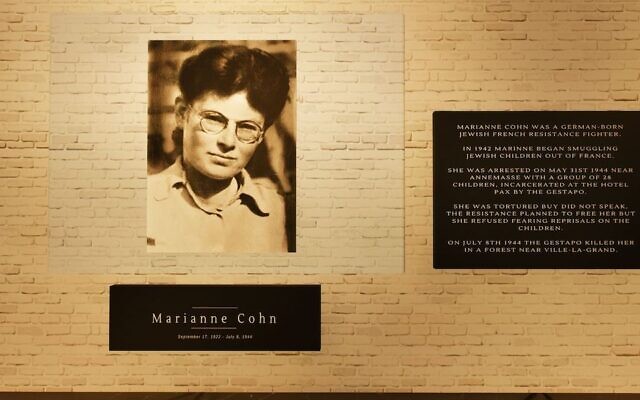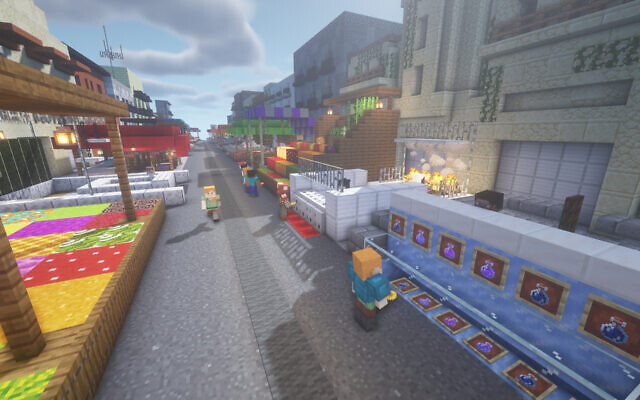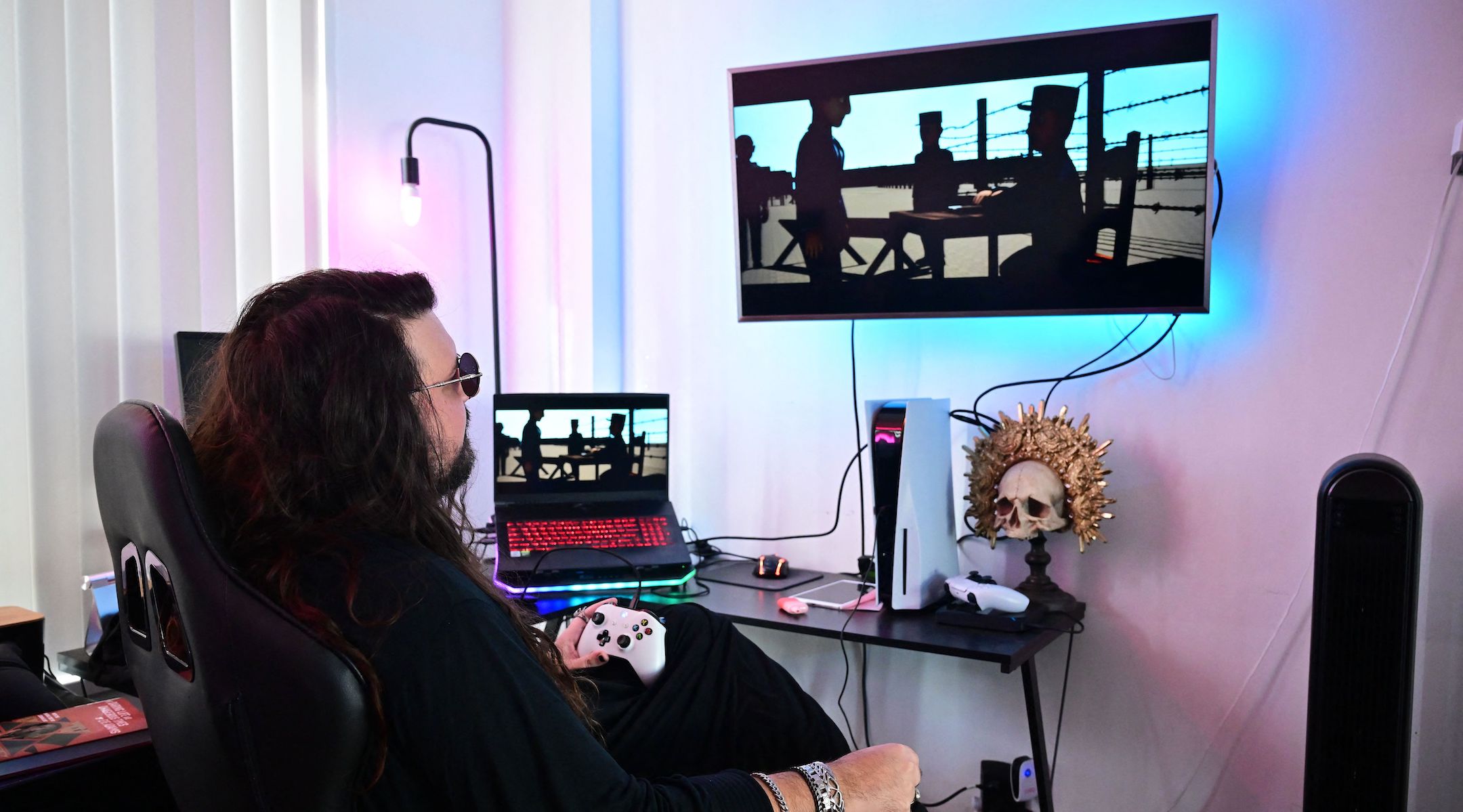(JTA) – There’s no way to win The Light in the Darkness, a new video game where the characters are members of a French-Jewish family in the years before and during the Holocaust.
No matter what choices the players make, they will be murdered by Nazis — a dark end that the game’s creator says is essential to its success as an educational tool.
“I didn’t want to make it seem like people in the Holocaust had a choice,” said Luc Bernard, a 37-year-old British-French video game designer who has spent his entire adult life developing The Light in the Darkness. “It was all pure luck, the people who managed to live.”
Bernard’s vision for the game is only one prong in his expansive, enduring and at times quixotic mission to bring Holocaust education to the video game landscape. This week, a virtual Holocaust museum called Voices of the Forgotten opened inside Fortnite, one of the most widely played games in the world, as the result of his efforts.
The museum includes general information about the Holocaust as well as plaques on lesser-known stories like the Tripolitania riots and Dutch resistance fighter Willem Arondéus; some of its information was pulled directly from Wikipedia. Still, Bernard is hopeful that it will lead to a better understanding of the Holocaust among gamers.
“The reality is, video games are the number-one-used platform now,” Bernard said. “They’re bigger than movies, they’re bigger than music. Video games are the future of storytelling. So that’s why I also saw this as kind of a perfect platform to educate about the Holocaust.”
Yet Bernard’s single-minded quest to use the medium to teach about the Holocaust continues to elicit deep skepticism — including among groups like the Anti-Defamation League that have identified antisemitism among gamers as an increasing problem.
“I think this is obviously a tough, probably impossible, educational piece to gamify,” said Brian Soileau, the chief business officer of Lost Tribe, an organisation that uses video games such as Fortnite and Minecraft to engage Jewish teens.

For Bernard, the path to a Fortnite Holocaust museum began when he was a teenager and learned about his own family’s Holocaust story. Raised without a Jewish identity in what he called “a rural, poor area of France,” Bernard was in high school when he discovered that his grandmother had been a British Jew who had helped rescue Jewish children on the Kindertransport, which granted thousands of children safe passage to the United Kingdom from Nazi-occupied territory during the Holocaust.
“Everyone hid it, pretty much,” Bernard said about the family history. His grandmother had changed her name several times and the family’s Judaism only emerged after a long-lost family member reappeared.
Soon after, he was shown Schindler’s List in school. The immersive story transported him to another time and place, one where the horrors of what happened to the Jews of Europe were presented in stark detail.
A gamer himself, he immediately realised that video games could offer a similarly immersive experience — and that games didn’t have to be “fun” to be illuminating.
In 2008, when he was 21, Bernard first shared blueprints for his planned venture: a Nintendo DS game called Imagination Is The Only Escape, which he envisioned as a surreal storybook journey into the fanciful mind of a Jewish child being rounded up by the Nazis. Players would experience horrors as illustrated metaphors, before suddenly being yanked back into “reality” — although no violence would be shown on screen.
From the game’s earliest stages of development, Bernard was quick to publicise it. But media attention about his efforts stirred up considerable backlash from people who he said misunderstood the project and thought he was being insensitive. Jewish and Holocaust memory organisations were insulted at what they believed was a desecration of the victims’ memories. Nintendo issued a statement saying it would not distribute the game in North America.
15 per cent of young gamers and 20 per cent of adults said they were exposed to white supremacist ideologies in video games last year — a proportion that the organisation says is on the rise.
“People are thinking, ‘Oh my God, a video game about the Holocaust,’” he recalled. “So it was quite divisive. You had some organisations be like, ‘What the f–k is he doing?’”
Bernard abandoned that game, blaming the backlash — though he briefly tried to resurrect the idea in 2013, launching a new crowdfunding campaign that proved unsuccessful. But even as he busied himself with work designing other games, he still couldn’t shake the idea of bringing Holocaust education to the games space, especially as online gaming communities boomed in recent years and antisemitism boomed alongside, and inside, them.
The gaming industry, which had already been growing steadily, exploded during the pandemic, generating more than $200 billion in revenue in 2022 — more than twice the value of the industry in 2016, and a number substantially bigger than movies and sports combined. There are around 3 billion active video game players worldwide, a number that includes players of so-called “casual” games on mobile devices.
The multi-billion-dollar games industry boasts a global user base that heavily skews young and male, and online multiplayer games have become a fertile recruiting ground for white nationalists and antisemites. In addition, popular game streamers and YouTubers, like PewDiePie, began dabbling in antisemitic rhetoric laced with heavy doses of irony, an approach that courted controversy and followers. The ADL found that 15 per cent of young gamers and 20 per cent of adults said they were exposed to white supremacist ideologies in video games last year — a proportion that the organisation says is on the rise.
Casual antisemitism, including Holocaust jokes, is so prevalent that some gamers say it can almost stop being noticeable. Jake Offenheim, Lost Tribe’s director of influencer marketing, said he has encountered so much antisemitism within gaming that it doesn’t faze him anymore.
“I’m an avid Jewish gamer. I’ve been playing video games my entire life, and I’ve been the victim of many Jewish slurs,” he said. “There’s definitely a subset of these people that are 13-year-old kids that think the funniest thing to say is, ‘You should have died in the gas chamber.’”
Decades of education initiatives have proceeded from the idea that learning about the Holocaust would make young adults less likely to joke about it or, in more extreme cases, less likely to adopt hateful ideologies. While that idea has faced challenges more recently, Bernard couldn’t shake it and decided to try again with a new Holocaust game built for a new generation of gamers.
By 2021, when he started on The Light in the Darkness, his efforts had been dormant for so long that the Nintendo DS had become obsolete. So he turned instead to newer platforms, overhauling his core idea to fit. Instead of fantasy and surrealism, his new game would be rooted in cold, hard reality — that of how the collaborationist Vichy government worked with the Nazis to round up Jews in his own country.
The game would incorporate authentic documents from the time period to show the bureaucracy the Nazis used to suppress the Jews. Its plot would be based on real survivor testimony, and its digital renderings of occupied France would hew as close to actual history as possible.
“The project hasn’t changed, but the intent behind it has,” he said of his vision, noting that his original idea of a “more artistic” approach to the Holocaust no longer seemed relevant as, in his eyes, the severity of antisemitism in gaming spaces increased. “Now it’s turned into something where I feel like it has to be done because things are getting so bad,” he said, speaking to his desire to make the game “100 per cent accurate because you don’t want anyone to say, ‘This is inaccurate and then the Holocaust didn’t happen.’”

Most significantly, every character would die. (The outcome is similar to that of a Holocaust video game that serves as a plot point in the 2022 bestseller Tomorrow and Tomorrow and Tomorrow, by Jewish Korean-American novelist Gabrielle Zevin. “Everyone loses,” the 19-year-old who develops the game says, to plaudits from her professors.)
Over the last few months, Bernard has been rolling out the game’s release on PC, Xbox One and PlayStation 5. He’s giving it away for free — “I’m insane,” he said, laughing, about this decision. “I’m absolutely bonkers” — and accompanying its release with museum exhibits, public talks and, most visibly, the Fortnite installation. More than 500,000 people have so far played and finished The Light in the Darkness, Bernard said.
Bernard’s game and approach have drawn mixed responses — including about whether it can be pulled off respectfully enough to still be engaging.
Andrew Denning, director of the museum studies program at the University of Kansas, who has published papers on video games and history, said efforts to bring Holocaust education to the games space are “incredibly important.” But he said he thought building a game without traditional game elements, like winning, was liable to turn players off.
“People still play games to have this sense of agency, to solve problems, to ‘win,’” Denning said. “Recognising the incredibly narrow set of choices that individuals who were targeted during the Holocaust had, that doesn’t make for a compelling game.”
The game would incorporate authentic documents from the time period to show the bureaucracy the Nazis used to suppress the Jews. Its plot would be based on real survivor testimony, and its digital renderings of occupied France would hew as close to actual history as possible.
The choice not to allow anyone to win, Denning noted, has implications beyond what it’s like to play the game. “The experience of victims of the Holocaust, and even those who survive, is [of] being almost entirely stripped of agency,” he said. (The vast majority of French Jews did survive the Holocaust, making it an outlier in Nazi-occupied Europe.)
Offenheim, too, says he sees potential in using video games to teach the Holocaust. “I think what he’s trying to do is a super noble cause,” he said about Bernard. “I think bringing accessible Holocaust education on the Internet has to be the way of the future.”
But Bernard’s approach could have drawbacks, Offenheim said. Lost Tribe has recreated several Israeli locations in Minecraft for its community and is developing a game to be hosted within Fortnite to teach about the siege of Masada during the Jewish-Roman Wars of the 1st century. So he knows that these games’ restrictions on religious and violent imagery can be a limitation.
“Doing it through Fortnite might bring its own host of challenges, in terms of respect and in terms of what you can and can’t show,” Offenheim said, noting that Lost Tribe was not allowed to include a Star of David in its virtual Jewish summer camp. (He got his job after recreating Camp Ramah in Canada inside Minecraft as a pandemic activity.)

Lost Tribe is working with the ADL on broader strategies for combating the kind of antisemitism young people often encounter online, including in games. The group reports instances of antisemitism on its Discord channel through the ADL, adding to its data collection about hatred against Jews in online spaces, and it also provides guidance on how to think about antisemitism on platforms like TikTok.
“They know that there’s an area they’re leaning into as far as antisemitism in online spaces, and we’re able to give a lot of feedback on that,” Soileau said.
Bernard, on the other hand, has harsh words for establishment Jewish groups who, he says, haven’t taken video games seriously enough. His request to partner with the ADL on his game have been met with “total silence,” he says, accusing the Jewish civil-rights group and its ilk of being more focused on surveys than solutions.
“‘Sign a petition to make Activision change things,’” he said, invoking the blockbuster publisher of the Call of Duty series to mock the approach the ADL takes in addressing antisemitism concerns that pop up in video games. “You really think a big, billion-dollar company is going to give a s–t about your thing?”
An ADL spokesperson would not comment on Bernard’s characterisation of the group. But in a statement, its CEO Jonathan Greenblatt called Bernard’s Fortnite museum “potentially worthwhile.”
Greenblatt said he was encouraged by the fact that virtual visitors to the Fortnite museum will have their onscreen communication tools disabled and will be unable to manipulate the environment. “We commend the creators of this ‘Fortnite’ experience for utilising one of the most influential mediums of our time — online games — to build a new kind of Holocaust museum,” he said.
An ADL spokesperson added that the group isn’t focusing on projects like the museum because its interest in the games space is primarily focused on how online multiplayer games function as “social platforms.”
In a subsequent statement to The New York Times, Greenblatt took a harsher view of the Fortnite museum’s utility, saying, “Until the game industry can change the norms of hate and abuse in online multiplayer games, we cannot view experiences like these as a true alternative to more traditional forms of Holocaust education.”
Over the course of the 15 years that Bernard has been trying to bring Holocaust education into the games space, one consistent anxiety from establishment Jewish groups has been around whether the setting allows for proper respect to be paid to the subject matter. That worry helped doom his first game attempt, and it has been a theme of the early responses to the Fortnite museum, as well. But Soileau thinks such concerns are missing the point of an endeavor like this, which is to reach players where they are most likely to pay attention.
“Is it disrespectful for you to be in a Spider-Man avatar costume while reading some of the plaques in the Holocaust Museum on Fortnite?” he asked. “That’s the part we have to get over. This is not meant to be like going to Yad Vashem, right? … We’re all about meeting kids where they are, and that’s meeting them where they are. They are online, in a Spider-Man costume, and that’s OK, let’s teach.”
The point of an endeavor like this … is to reach players where they are most likely to pay attention.
How much can one well-intentioned game turn the tide of antisemitism in the games space? Bernard likes to point to another game he developed, in between his Holocaust projects: a free-to-play online game sponsored by People for the Ethical Treatment of Animals, the animal-rights group. He saw firsthand how even players skeptical of the group’s mission found themselves playing, and enjoying, the game.
“It was very interesting to see them on YouTube, because they were like, ‘F–k PETA, I’m gonna eat a cow or something,’” Bernard recalled. “They started out with that. But towards the end, they started [saying], ‘Yeah, animal rights are a thing. We should be nice to animals.’”
“That’s pretty much what I think will happen,” he said, going so far as to predict that even people who hate Jews will want to play his game “and might get emotional from the story.”
“I’m not saying I’m going to solve the Nazi, white supremacist problem,” he said. “But I think it will help in reducing it.”


comments